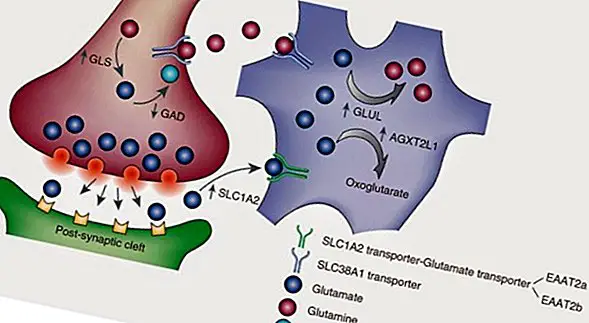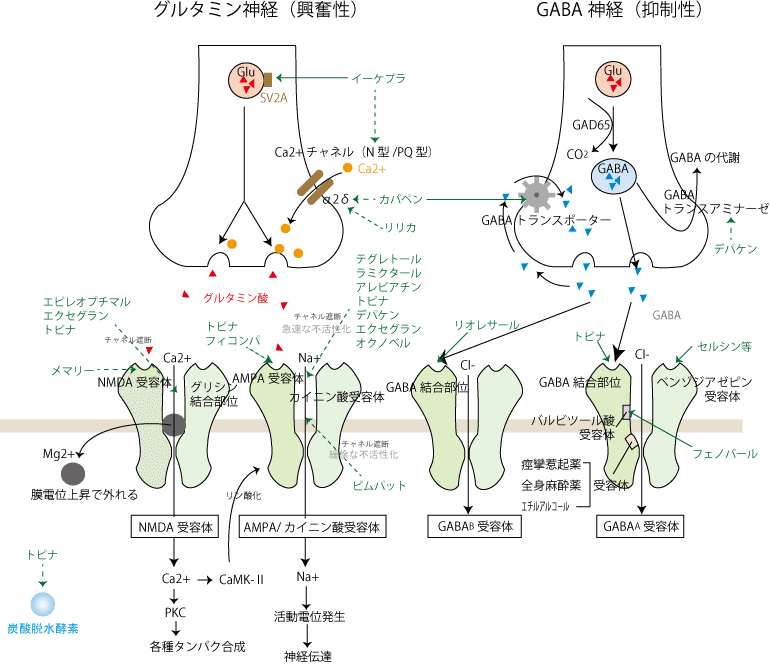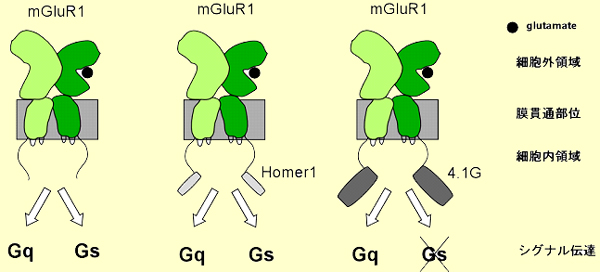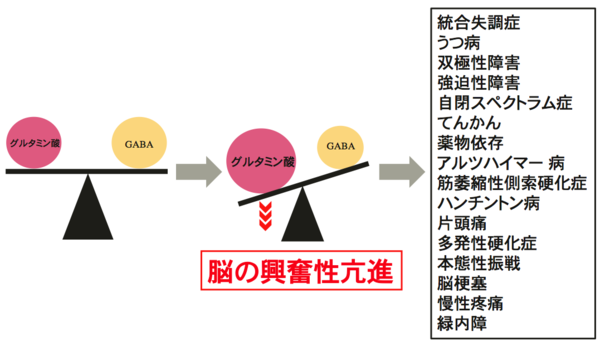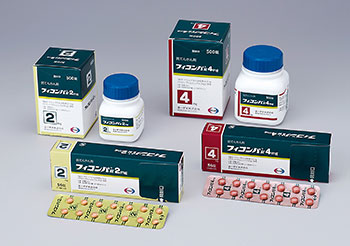Images of カイニン酸型グルタミン酸受容体

脳の働きを分子から考える その3 〜孤児からオーガナイザーへ デルタ型グルタミン酸受容体の話(2020年7月20日公開)図1:遺伝子クローニングが行われていた当時、グルタミン酸受容体がNMDA型やAMPA/カイニン酸型というイオンチャネルに分類されることは予想されていたが、デルタ型についてはリガンドも機能も不明であり、長い間"孤児受容体"と呼ばれていた。図2:GluD2サブユニットはニューレキシン( Neurexin )とCbln1と三者複合体を構成し、平行線維-プルキンエ細胞間のシナプス結合を形成させるシナプスオーガナイザーとして機能する。一方、 GluD2サブユニットの細胞外のリガンド結合領域にはD-セリンが結合し、細胞内C末端領域にはチロシン脱リン酸化酵素PTPMEGが結合して、長期抑圧に重要な役割を果たしている。図3:(A)組織学的解析と(B)生化学的解析より明らかとなったポストシナプスでのデルタ型グルタミン酸受容体の局在様式。同一のシナプスにGluD1とGluD2の両方のサブユニットが存在し、免疫沈降法によりGluD1サブユニット抗体でGluD2サブユニットが共沈することが示された。(C)うつ様行動の指標となる強制水泳テストにおいてGluD1欠損マウスが示す無動時間の増加。この異常は抗うつ薬イミプラミンとフルオキセチンにより回復することが示された。(文献33, 34より改変)Hollmann M, Heinemann S: Cloned glutamate receptors. Annual review of neuroscience 1994, 17:31-108.Yamazaki M, Araki K, Shibata A, Mishina M: Molecular cloning of a cDNA encoding a novel member of the mouse glutamate receptor channel family. Biochemical and biophysical research communications 1992, 183(2):886-892.Araki K, Meguro H, Kushiya E, Takayama C, Inoue Y, Mishina M: Selective Expression of the Glutamate Receptor Channel δ2 Subunit in Cerebellar Purkinje Cells. Biochemical and biophysical research communications 1993, 197(3):1267-1276.Lomeli H, Sprengel R, Laurie DJ, Köhr G, Herb A, Seeburg PH, Wisden W: The rat delta-1 and delta-2 subunits extend the excitatory amino acid receptor family. FEBS letters 1993, 315(3):318-322.Konno K, Matsuda K, Nakamoto C, Uchigashima M, Miyazaki T, Yamasaki M, Sakimura K, Yuzaki M, Watanabe M: Enriched expression of GluD1 in higher brain regions and its involvement in parallel fiber-interneuron synapse formation in the cerebellum. The Journal of neuroscience : the official journal of the Society for Neuroscience 2014, 34(22):7412-7424.Kashiwabuchi N, Ikeda K, Araki K, Hirano T, Shibuki K, Takayama C, Inoue Y, Kutsuwada T, Yagi T, Kang Y et al: Impairment of motor coordination, Purkinje cell synapse formation, and cerebellar long-term depression in GluR delta 2 mutant mice. Cell 1995, 81(2):245-252.Kohda K, Kakegawa W, Matsuda S, Yamamoto T, Hirano H, Yuzaki M: The δ2 glutamate receptor gates long-term depression by coordinating interactions between two AMPA receptor phosphorylation sites. Proceedings of the National Academy of Sciences 2013, 110(10):E948-E957.Takeuchi T, Ohtsuki G, Yoshida T, Fukaya M, Wainai T, Yamashita M, Yamazaki Y, Mori H, Sakimura K, Kawamoto S et al: Enhancement of both long-term depression induction and optokinetic response adaptation in mice lacking delphilin. PloS one 2008, 3(5):e2297.Kakegawa W, Miyazaki T, Kohda K, Matsuda K, Emi K, Motohashi J, Watanabe M, Yuzaki M: The N-terminal domain of GluD2 (GluRdelta2) recruits presynaptic terminals and regulates synaptogenesis in the cerebellum in vivo. The Journal of neuroscience : the official journal of the Society for Neuroscience 2009, 29(18):5738-5748.Kakegawa W, Miyoshi Y, Hamase K, Matsuda S, Matsuda K, Kohda K, Emi K, Motohashi J, Konno R, Zaitsu K et al: D-serine regulates cerebellar LTD and motor coordination through the δ2 glutamate receptor. Nature neuroscience 2011, 14(5):603-611.Kohda K, Wang Y, Yuzaki M: Mutation of a glutamate receptor motif reveals its role in gating and delta2 receptor channel properties. Nature neuroscience 2000, 3(4):315-322.Ikeno K, Yamakura T, Yamazaki M, Sakimura K: The Lurcher mutation reveals Ca(2+) permeability and PKC modification of the GluRdelta channels. Neuroscience research 2001, 41(2):193-200.Ady V, Perroy J, Tricoire L, Piochon C, Dadak S, Chen X, Dusart I, Fagni L, Lambolez B, Levenes C: Type 1 metabotropic glutamate receptors (mGlu1) trigger the gating of GluD2 delta glutamate receptors. EMBO reports 2014, 15(1):103-109.Takeuchi T, Miyazaki T, Watanabe M, Mori H, Sakimura K, Mishina M: Control of synaptic connection by glutamate receptor delta2 in the adult cerebellum. The Journal of neuroscience : the official journal of the Society for Neuroscience 2005, 25(8):2146-2156.Miyazaki T, Yamasaki M, Takeuchi T, Sakimura K, Mishina M, Watanabe M: Ablation of glutamate receptor GluRδ2 in adult Purkinje cells causes multiple innervation of climbing fibers by inducing aberrant invasion to parallel fiber innervation territory. The Journal of neuroscience : the official journal of the Society for Neuroscience 2010, 30(45):15196-15209.Yamasaki M, Miyazaki T, Azechi H, Abe M, Natsume R, Hagiwara T, Aiba A, Mishina M, Sakimura K, Watanabe M: Glutamate receptor delta2 is essential for input pathway-dependent regulation of synaptic AMPAR contents in cerebellar Purkinje cells. The Journal of neuroscience : the official journal of the Society for Neuroscience 2011, 31(9):3362-3374.Hirai H, Pang Z, Bao D, Miyazaki T, Li L, Miura E, Parris J, Rong Y, Watanabe M, Yuzaki M et al: Cbln1 is essential for synaptic integrity and plasticity in the cerebellum. Nature neuroscience 2005, 8(11):1534-1541.Matsuda K, Miura E, Miyazaki T, Kakegawa W, Emi K, Narumi S, Fukazawa Y, Ito-Ishida A, Kondo T, Shigemoto R et al: Cbln1 is a ligand for an orphan glutamate receptor delta2, a bidirectional synapse organizer. Science (New York, NY) 2010, 328(5976):363-368.Uemura T, Lee SJ, Yasumura M, Takeuchi T, Yoshida T, Ra M, Taguchi R, Sakimura K, Mishina M: Trans-synaptic interaction of GluRdelta2 and Neurexin through Cbln1 mediates synapse formation in the cerebellum. Cell 2010, 141(6):1068-1079.Matsuda K, Yuzaki M: Cbln family proteins promote synapse formation by regulating distinct neurexin signaling pathways in various brain regions. The European journal of neuroscience 2011, 33(8):1447-1461.Kakegawa W, Mitakidis N, Miura E, Abe M, Matsuda K, Takeo YH, Kohda K, Motohashi J, Takahashi A, Nagao S et al: Anterograde C1ql1 signaling is required in order to determine and maintain a single-winner climbing fiber in the mouse cerebellum. Neuron 2015, 85(2):316-329.Matsuda K, Budisantoso T, Mitakidis N, Sugaya Y, Miura E, Kakegawa W, Yamasaki M, Konno K, Uchigashima M, Abe M et al: Transsynaptic Modulation of Kainate Receptor Functions by C1q-like Proteins. Neuron 2016, 90(4):752-767.Yuzaki M: The C1q complement family of synaptic organizers: not just complementary. Current Opinion in Neurobiology 2017, 45:9-15.Utine GE, Haliloğlu G, Salancı B, Çetinkaya A, Kiper PÖ, Alanay Y, Aktaş D, Boduroğlu K, Alikaşifoğlu M: A Homozygous Deletion in GRID2 Causes a Human Phenotype With Cerebellar Ataxia and Atrophy. Journal of Child Neurology 2013, 28(7):926-932.Hills LB, Masri A, Konno K, Kakegawa W, Lam AT, Lim-Melia E, Chandy N, Hill RS, Partlow JN, Al-Saffar M et al: Deletions in GRID2 lead to a recessive syndrome of cerebellar ataxia and tonic upgaze in humans. Neurology 2013, 81(16):1378-1386.Maier A, Klopocki E, Horn D, Tzschach A, Holm T, Meyer R, Meyer T: De novo partial deletion in GRID2 presenting with complicated spastic paraplegia. Muscle & Nerve 2014, 49(2):289-292.Strehle E-M, Yu L, Rosenfeld JA, Donkervoort S, Zhou Y, Chen T-J, Martinez JE, Fan Y-S, Barbouth D, Zhu H et al: Genotype-phenotype analysis of 4q deletion syndrome: Proposal of a critical region. American Journal of Medical Genetics Part A 2012, 158A(9):2139-2151.Nenadic I, Maitra R, Scherpiet S, Gaser C, Schultz CC, Schachtzabel C, Smesny S, Reichenbach JR, Treutlein J, Mühleisen TW et al: Glutamate receptor delta 1 (GRID1) genetic variation and brain structure in schizophrenia. Journal of Psychiatric Research 2012, 46(12):1531-1539.Griswold AJ, Ma D, Cukier HN, Nations LD, Schmidt MA, Chung RH, Jaworski JM, Salyakina D, Konidari I, Whitehead PL et al: Evaluation of copy number variations reveals novel candidate genes in autism spectrum disorder-associated pathways. Human molecular genetics 2012, 21(15):3513-3523.Tao W, Díaz-Alonso J, Sheng N, Nicoll RA: Postsynaptic δ1 glutamate receptor assembles and maintains hippocampal synapses via Cbln2 and neurexin. Proceedings of the National Academy of Sciences 2018, 115(23):E5373-E5381.Yadav R, Gupta SC, Hillman BG, Bhatt JM, Stairs DJ, Dravid SM: Deletion of Glutamate Delta-1 Receptor in Mouse Leads to Aberrant Emotional and Social Behaviors. PloS one 2012, 7(3):e32969.Yadav R, Hillman BG, Gupta SC, Suryavanshi P, Bhatt JM, Pavuluri R, Stairs DJ, Dravid SM: Deletion of Glutamate Delta-1 Receptor in Mouse Leads to Enhanced Working Memory and Deficit in Fear Conditioning. PloS one 2013, 8(4):e60785.Nakamoto C, Konno K, Miyazaki T, Nakatsukasa E, Natsume R, Abe M, Kawamura M, Fukazawa Y, Shigemoto R, Yamasaki M et al: Expression mapping, quantification, and complex formation of GluD1 and GluD2 glutamate receptors in adult mouse brain. The Journal of comparative neurology 2020, 528(6):1003-1027.Nakamoto C, Kawamura M, Nakatsukasa E, Natsume R, Takao K, Watanabe M, Abe M, Takeuchi T, Sakimura K: GluD1 knockout mice with a pure C57BL/6N background show impaired fear memory, social interaction, and enhanced depressive-like behavior. PloS one 2020, 15(2):e0229288.Otsuka S, Konno K, Abe M, Motohashi J, Kohda K, Sakimura K, Watanabe M, Yuzaki M: Roles of Cbln1 in Non-Motor Functions of Mice. The Journal of neuroscience : the official journal of the Society for Neuroscience 2016, 36(46):11801-11816.









